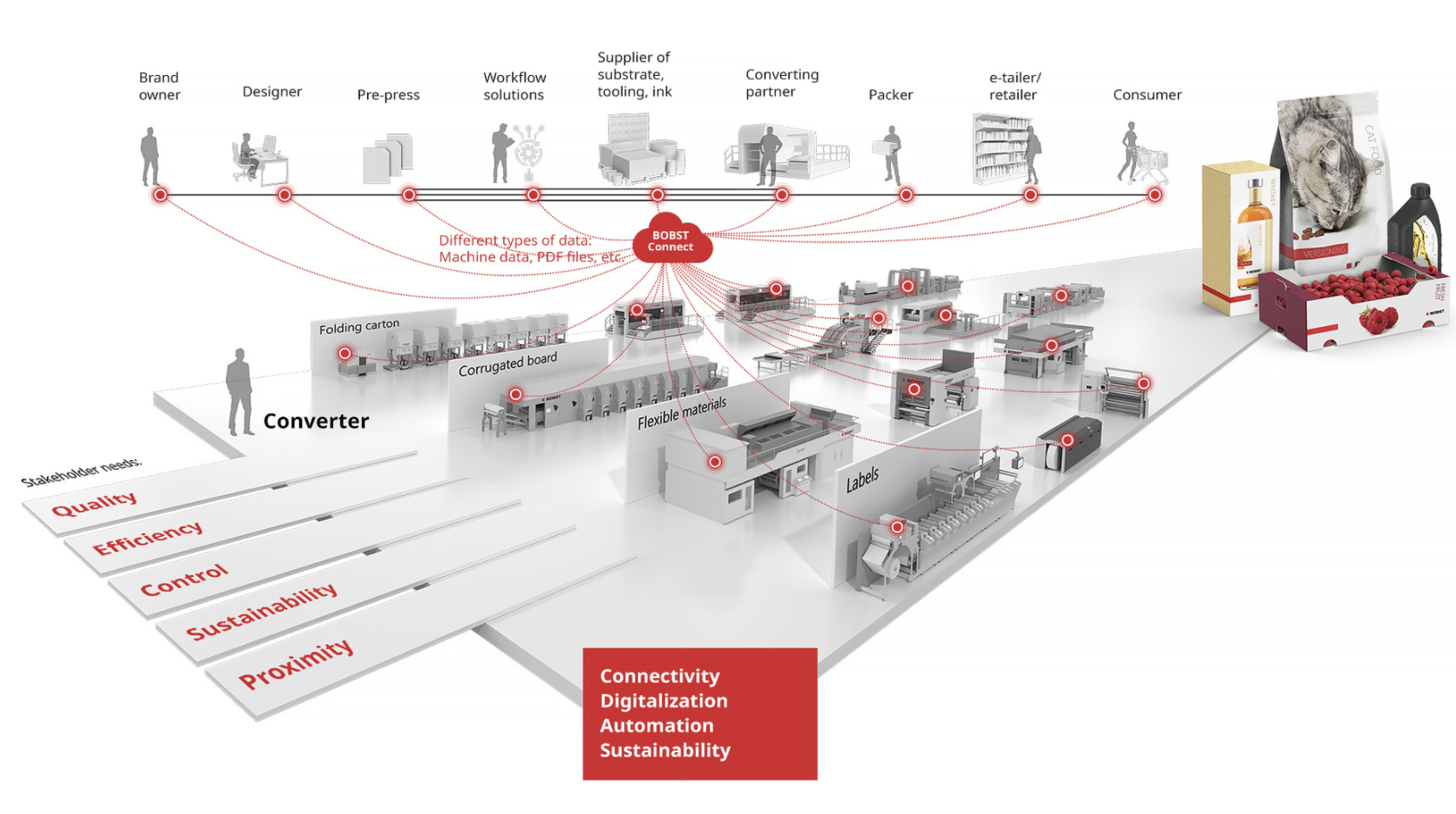CEO Jean-Pascal Bobst said the Swiss manufacturer’s open architecture cloud platform Bobst Connect was at the heart of this vision, and described workflow as the biggest challenge for the sector.
“This new vision for Bobst is a revolution for us, and a major change for our clients,” he stated.
“The main benefit for our clients will be to optimise the quality and the cost per box or per label. Very simple to say, but very complex to achieve.”
He described the four cornerstones of the firm’s vision as: connectivity, automation, digitalisation, and sustainability.
“The digitalisation of printing processes is the most visible element of progress in the packaging industry,” he stated.
“The coming years will likely see a major acceleration of digital printing and converting. While the solutions are becoming available, the biggest challenge for printers and converters is not the individual printing machines, but rather the entire workflow, encompassing converting.”

Last month Bobst announced that it would no longer be attending Drupa, or most other industry trade shows, as part of a fresh strategy involving virtual customer experiences that would also help it achieve its sustainability goals.
Bobst also said that if Drupa had been able to take place in its original time frame – the show would have opened next week on 16 June – then the manufacturer would still have exhibited in Dusseldorf. But the postponement to April 2021 and crowded event calendar in 2021 caused the firm to review its strategy.
New products just unveiled by Bobst this week include the Mastercut 106 PER die-cutter, incorporating new automation features reducing setup times and the need for operator intervention.
Bobst said it was ideal for short- and long-run work as a result.
Die-cutting productivity has been further enhanced with TooLink Connected Tooling, allowing the die-cutting machine to automatically detect the type of tool being used. It is available for all SP 106 devices version 3 and above, and can be retrofitted.
Also new is the MasterStar sheet-to-sheet laminator that runs at 10,000sph. “It matches printed sheet and substrate sheet with an accuracy never seen before on a sheet-to-sheet laminator”.
The MasterStar handles sheets format up to 2.05m, with Bost claiming there was “no equivalent product at this price point”, although pricing was not disclosed and is dependant upon the configuration and options selected.
Two other sheet-to-sheet laminators, the ExpertStar and NovaStar have also joined the range to cover differing production requirements from low- to high-end.
Bobst also announced its new AccuCheck inline quality control system, billed as enabling “zero-fault packaging”. It is capable of inspecting print elements including foil-to-print registration, imperfections including splashes and scratches, carton damage from external elements, and embellishment integrity such as missing foil, varnish or embossing.
“In the current situation, automation and connectivity are more important than ever, and greater digitalisation is helping to drive these,” Bobst added. “Meanwhile, achieving greater sustainability is arguably the single most important current goal in all manufacturing. By uniting all of these elements in our products and solutions, we are shaping the future of the packaging world.”
In flexible packaging the new Master CI incorporates a number of automation features, and Bobst said the press, which has a web width from 1.3m-2.2m and a top speed of 800m/min, could be up and running in a four week timeframe from delivery to production startup.
It features the firm’s OneECG extended gamut printing system that originated in its label printing business. “We have brought that to flexo corrugated and CI flexo and gravure,” Bobst said. “What is new is that the colour gamut can be really mastered to the maximum. That means 98%-plus of all colours. We are pushing it because of sustainability. It avoids waste, shortens setup times, and because you keep the ink in the machine you save ink.”
Bobst’s new Master M6 flexo press also features OneECG and is targeted at labels, flexibles and folding carton applications.
Other new products just announced include the Nova D800 fully-automated laminator for flexibles, and a new Digital Inspection Table that handles a sheet size of 2.8m x 1.6m.
Regarding developments at its Mouvent digital printing subisidary, which makes inkjet presses for label and textile printing, Bobst commented: “We are doing very well in label, we are very happy with the start-up, which took quite some time. The quality of print is excellent, almost the same as the best on the market.
“Bobst spent four years and invested a huge amount of money and also passion into this technology, and we are very happy to say that digital printing machines, with UV and water-based inks, are a success today and we ramp up production as we speak.”
In terms of dealing with the impact of the Covid-19 pandemic, Bobst said separately that the group had been ramping up activities worldwide, while complying with all the relevant country-specific restrictions, since the third week of April. It said the travel ban had proved particularly difficult for the business.
“As for many other companies, the group faces a slowdown in orders caused by the uncertainty in the market. On the positive side, the main industries we serve – food, pharma and e-commerce in general – are essential industries in the current environment and some of our customers are experiencing a sharp increase in demand, while other segments of the industry are impacted negatively,” the group stated.







